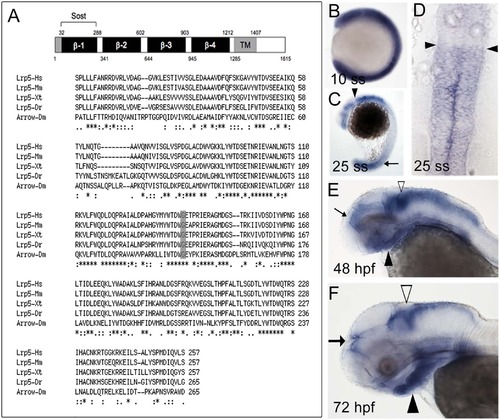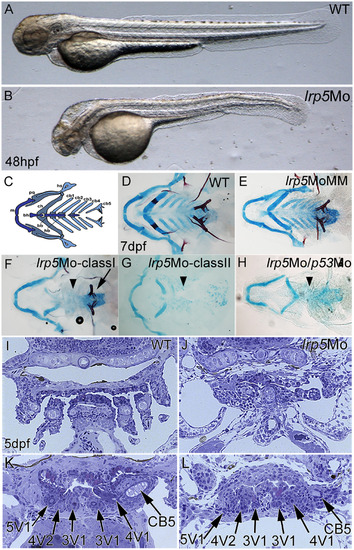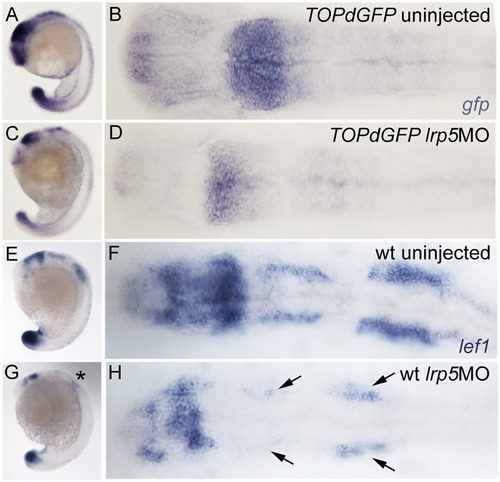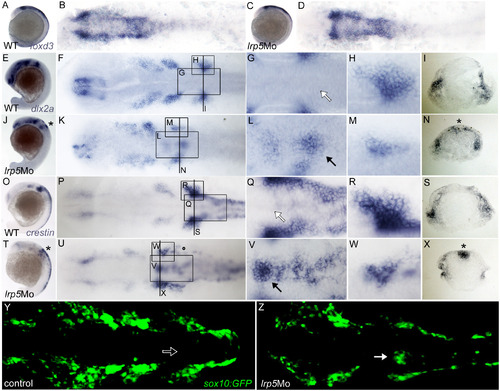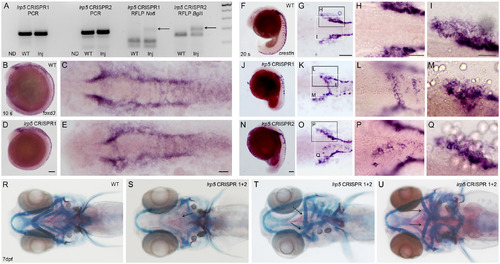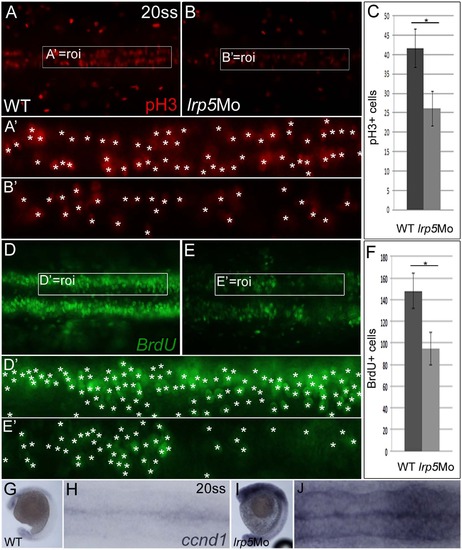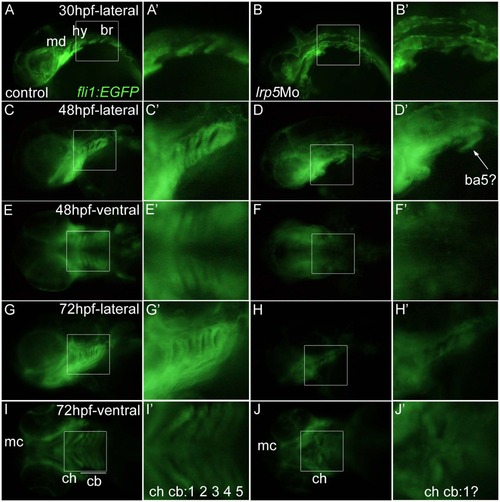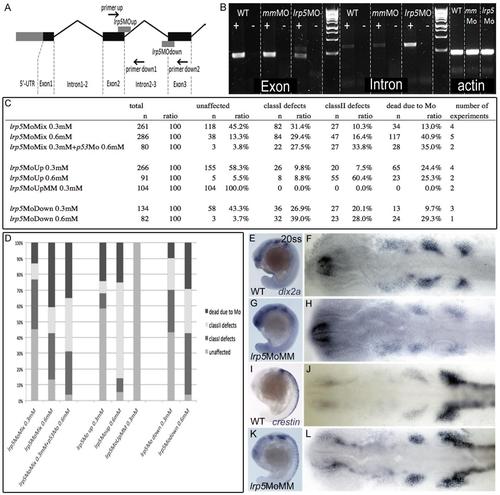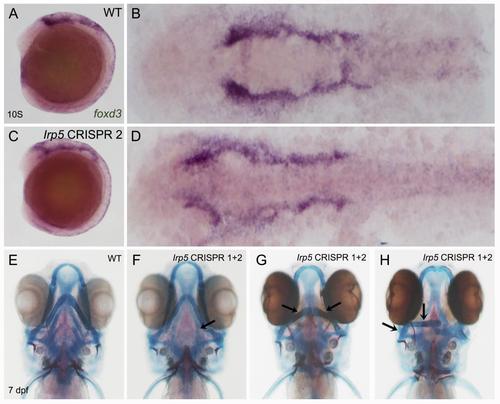- Title
-
The Wnt Co-Receptor Lrp5 Is Required for Cranial Neural Crest Cell Migration in Zebrafish
- Authors
- Willems, B., Tao, S., Yu, T., Huysseune, A., Witten, P.E., Winkler, C.
- Source
- Full text @ PLoS One
|
Lrp5 sequence alignment and expression pattern. (A) Schematic illustration of predicted Lrp5 protein domains (top). Numbers indicate amino acid positions and refer to human Lrp5. Grey boxes represent signal peptide (1?32) and transmembrane domain (TM), respectively. β-1 to β-4 indicate β-propeller domains 1 to 4. The β-1 domain is proposed to bind to Sost. Bottom: Alignment of amino acid sequences in the β-1 domain. Glycine at position 171, which is mutated to valine in human patients with high bone mass phenotypes [25] is highlighted in grey. (B-F) Spatiotemportal expression of lrp5 during embryonic and larval development: Expression at 10 ss (B), 25 ss (C,D), 48 hpf (E) and 72 hpf (F). Anterior is to the left in B,C,E,F and to the top in D. EXPRESSION / LABELING:
|
|
Knock-down of lrp5 leads to defects in the craniofacial skeleton but not teeth. (A,B) Morphology of wild-type and lrp5 morphant embryos at 48 hpf. Note inflated hindbrain in morphant. (C) Schematic illustration of viscerocranial skeleton formed mainly by CNCCs (different colors represent different groups of skeletal elements; bb, basibranchial; bh, basihyal; cb, ceratobranchial; ch, ceratohyal; hb, hypobranchial; hs, hyosymplectic; m, Meckel?s cartilage; pq, palatoquadrate). (D-H) Combined bone and cartilage staining at 7 dpf of wild-type (D), lrp5MM morphant (E), lrp5 morphant classI (F), classII (G) and lrp5/p53 compound morphant (H). Note that morphants show absence of ceratobranchials (arrowheads) while 5th ceratobranchial and pharyngeal teeth (arrow) are present in classI morphants. (I-L) Cross sections through 5 dpf larvae. Wild-type (I) shows ceratobranchials, which are lost in lrp5 morphant (J). More posterior sections show that wild-type (K) and lrp5 morphants (L) have normally formed pharyngeal teeth (arrows). Anterior is to the left in A-H. |
|
Knock-down of lrp5 results in reduced canonical Wnt signaling. (A-D) TOPdGFP embryos at 20 ss analyzed for gfp transcription. (A,B) Uninjected control, (C,D) lrp5 morphant. Note that gfp transcripts are down-regulated in morphants. (E-H) 20 ss embryos expressing lef1. (E,F) Wild-type embryo, (G,H) lrp5 morphant. Note that lef1 expression is down-regulated in morphants, particularly in the CNCC regions (see asterisk in G and arrows in H). Anterior is to the left in all images. EXPRESSION / LABELING:
PHENOTYPE:
|
|
lrp5 morphants display normal induction but defective migration of CNCCs. (A-D) Embryos at 10 ss stained for foxd3 transcripts. (A,B) Wild-type embryo, (C,D) lrp5 morphant. Note normal pattern of foxd3 expression in morphants. (E-N) Embryos at 20 ss stained for dlx2a. (E-I) Wild-type embryo, (J-N) lrp5 morphant. Note ectopic dlx2a expression at dorsal neuroepithelium of rhombomere 6 in lrp5 morphants (asterisk in J,N; arrow in L) and that streams of branchial migratory CNCCs are reduced (M). (O-X) crestin expression in embryos at 20 ss. (O-S) Wild-type embryo, (T-X) lrp5 morphant. Note ectopic crestin expression at dorsal neuroepithelium of rhombomere 6 in lrp5 morphants (asterisk in T,X; arrow in V) and that streams of branchial migratory CNCCs are reduced (M). (Y,Z) Confocal projections of sox10:GFP embryos at 20 ss showing GFP expression in CNCCs. (Y) Uninjected control embryo, (Z) lrp5 morphant. Note ectopic GFP cells at dorsal neuroepithelium of rhombomere 6 in lrp5 morphants (arrow) and that streams of branchial migratory CNCCs are reduced. Anterior is to the left in all images, except cross sections. Boxed areas indicate regions shown in higher magnification in accompanying images. Positions of cross sections in I,N,S,X are indicated by lines in F,K,P,U. EXPRESSION / LABELING:
PHENOTYPE:
|
|
lrp5 CRISPR/Cas9 injected embryos display normal CNCC induction, but defective CNCC cell migration. (A) RFLP analysis of 15 pooled embryos per sample. Both, lrp5 CRISPR1 and CRISPR2 generate mutations indicated by presence of undigested mutant bands after NotI and BglII digestion (right lanes), respectively. Left lanes show non-digested (ND) PCR products. (B-E) In situ hybridization showing foxd3 expression at 10 ss in wild-type embryos (B, C) and lrp5 CRISPR1 injected embryos (D,E). (F-Q) crestin expression at 20 ss in wild-type embryos (F-I), lrp5 CRISPR1 injected embryos (J-M), and lrp5 CRISPR2 injected embryos (N-Q). (R-U) Combined bone and cartilage staining at 7 dpf in wild-type (R) and lrp5 CRISPR1 and CRISPR2 co-injected embryos showing cartilage defects with different degrees of severity. Note absence of ceratobranchials 1?4 (in S; arrow), and flipped ceratohyal (in T,U; arrows). (B,D,F,J,N) Lateral views with anterior to the left. All remaining images are dorsal views, except (R-U), which are ventral views. Higher magnification views of areas boxed in (G,K,O) are shown in accompanying images (I, M and Q, white boxes) and (H, L and P, black boxes). Note ectopic crestin positive cells in dorsal neuroepithelium (K,L,O,P) and reduced migratory CNCCs streams (K,M,O,Q) in lrp5 CRISPR injected embryos. Scale bars: 100 Ám (D,G,N) and 50Ám (E,H,I). EXPRESSION / LABELING:
PHENOTYPE:
|
|
Proliferation of premigratory CNCCs is affected by knock-down of lrp5. (A,B) 20 ss embryos stained for pH3 cells in M-phase. (A) Wild-type embryo, (B) lrp5 morphant. Frames demarcate area of cell count (roi, region of interest) and are magnified in (A′,B′) (counted nuclei marked by asterisks). Note that in lrp5 morphants pH3 positive cells are reduced in number. (C) Quantification of pH3 cell numbers in the neuroepithelium of rhombomeres 4?8. N = 9/11 (wild-type/lrp5 morphant). *P < 106, t-test. (D,E) 20 ss embryos stained for BrdU incorporation. (D) Wild-type embryo, (E) lrp5 morphant. Frames demarcate area of cell count (roi) and are shown with higher magnification in (D′,E′). Note that in lrp5 morphants, BrdU labeled cells are reduced in number. (F) Quantification of BrdU cell numbers in one unilateral neuroepithelium of rhombomeres 4?8. N = 9/11 (wild-type/lrp5 morphant). *P = 1.05x10-6, t-test. (G-J) ccnd1 expression in 20 ss embryos. (G,H) Wild-type embryo, (I,J) lrp5 morphant. Note that ccnd1 expression levels are increased in lrp5 morphants. Anterior is to the left in all images. EXPRESSION / LABELING:
PHENOTYPE:
|
|
Lower numbers of postmigratory CNCCs after lrp5 knock-down results in cranial skeleton malformations. (A-B′) fli1:EGFP embryos at 30 hpf. (A,A′) Uninjected control embryo, (B,B′) lrp5 morphant. Note that mandibular (md), hyoid (hy) and three branchial (br) patches of postmigratory CNCCs are well defined in wild-type but defective in lrp5 morphants. (C-F′) fli1:EGFP embryos at 48 hpf. (C,C′) Uninjected control embryo in lateral view, (D,D′) lrp5 morphant lateral view, (E,E′) uninjected control embryo ventral view, (F,F′) lrp5 morphant ventral view. Note that metameric morphology of pharyngeal arches is absent in lrp5 morphant. Only one arch, most likely the 5th branchial arch is present (ba5?). (G-J′) fli1:EGFP embryos at 72 hpf. (G,G′) Uninjected control embryo in lateral view, (H,H′) lrp5 morphant lateral view, (I,I′) uninjected control embryo ventral view (J,J′) lrp5 morphant ventral view. Note that in wild-type, cranial elements like Meckel?s cartilage (mc), ceratohyal (ch) and 1st to 5th ceratobranchials (cb 1?5) can be distinguished, whereas in lrp5 morphant only mc and ch are detectable while cbs are undefined. Anterior is to the left in all images. Boxed areas in X are magnified in X′. EXPRESSION / LABELING:
PHENOTYPE:
|
|
(A)Schematic representation of lrp5 transcript and Mo knock-down strategy. (B) Semi-quantitative RT-PCR in morphant embryos, +/- indicates presence or absence of reverse transcriptase. (C) Table presenting distribution of phenotypes upon injection with lrp5 MOs. (D) Graphical presentation of data shown in (C). (E-L) 20 ss embryos stained for different transcripts. (E,F) Wild-type embryo stained for dlx2a. (G,H) lrp5 mismatch morphant stained for dlx2a. (I,J) Wild-type embryo stained for crestin. (K,L) lrp5 mismatch morphant embryo stained for crestin. Note that mismatch Mo injection does not result in alterations of dlx2a/crestin expression patterns. Anterior is to the left in E-L. |
|
lrp5 CRISPR2 injected embryos display normal induction of CNCCs, but show defects in the craniofacial skeleton. (A-D) foxd3 expression at 10 ss in wild-type embryos (A,B) and lrp5 CRISPR2 injected embryos (n = 20/20 with normal foxd3 expression; C, D). (A,C) are lateral views with anterior to the left, (B,D) are dorsal views. (E-H) Additional examples for embryos with varying degrees of cartilage defects (class I, F; class II, G; class III, H). Combined bone and cartilage staining at 7 dpf of wild-type (E) and lrp5 CRISPR1+2 injected embryos. |

Unillustrated author statements EXPRESSION / LABELING:
|

